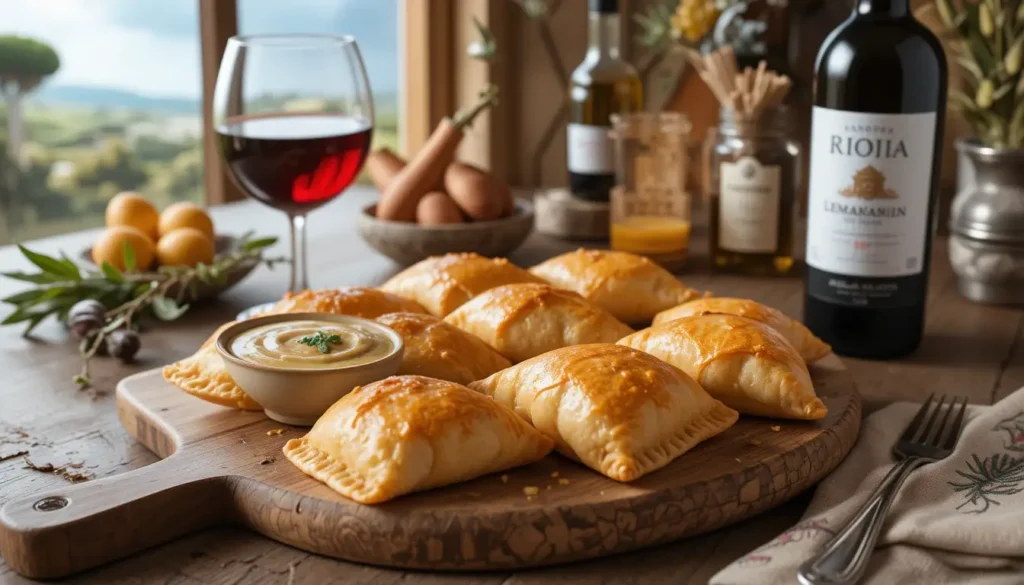Empanadas are small, hand-held pockets of pure joy. Whether you’re biting into a golden-brown, flaky Spanish empanada or enjoying the crispy, fried goodness of a Mexican version, one thing is for certain—these savory treats are packed with flavor and history. But what sets them apart? What is the difference between Spanish empanadas and Mexican empanadas? While they share a name and concept, these delicious pastries differ significantly in their ingredients, preparation methods, and cultural backgrounds. Let’s dive into their world and uncover the fascinating differences and similarities.
This article will serve as your ultimate guide where you will discover The difference between Spanish and Mexican empanadas
Table of Contents
The History of Empanadas: Origins and Cultural Significance
Empanadas have a rich history dating back centuries. Their origins can be traced to Galicia, a region in Spain, where empanadas were baked as large pies and filled with meat, fish, or vegetables. The term “empanada” comes from the Spanish word empanar, meaning “to wrap in bread.”
When Spanish explorers and colonizers traveled to the Americas, they brought their culinary traditions with them. Over time, these traditions fused with local ingredients and cooking styles, giving birth to regional variations—most notably the Mexican empanada.
In Spain, empanadas remained connected to their European roots, with influences from Moorish cuisine seen in the use of ingredients like saffron and olives. In Mexico, empanadas became a reflection of indigenous ingredients such as maize, chiles, and tropical fruits.
Today, empanadas represent far more than just food—they symbolize cultural exchange and adaptation. Each bite tells a story of tradition, innovation, and heritage.
Understanding Spanish Empanadas
Traditional Ingredients in Spanish Empanadas
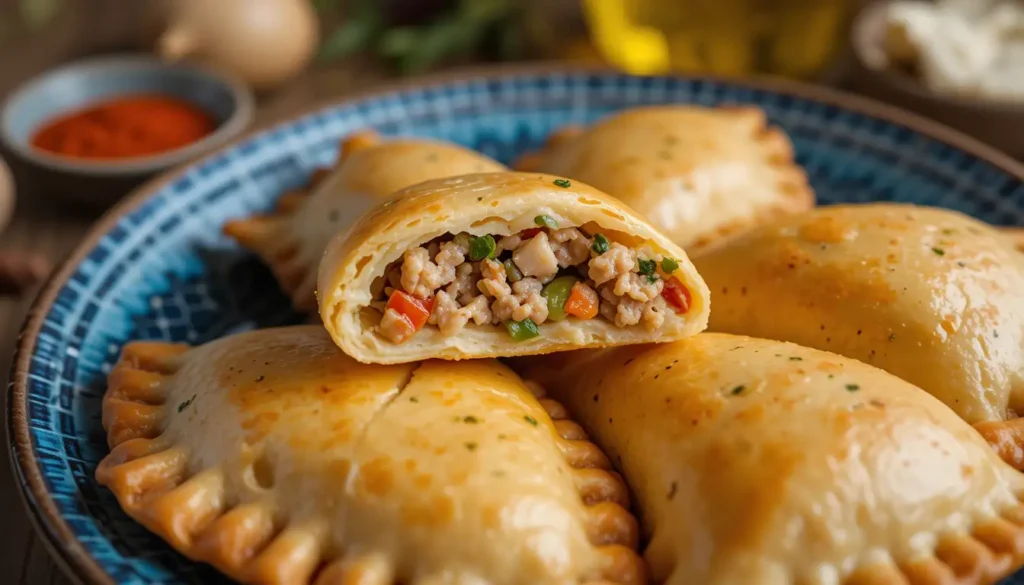
Spanish empanadas are all about simplicity and quality. The dough is typically made with wheat flour, olive oil, and sometimes a hint of white wine, which adds a subtle depth of flavor. Spanish empanada dough is flaky, similar to a savory pie crust, and often baked to golden perfection.
The fillings are usually savory, with an emphasis on seafood, meats, and vegetables. The most iconic Spanish empanada is the empanada gallega, a large pie-like version filled with tuna, onions, peppers, and tomatoes. Other popular fillings include:
- Chorizo and Potatoes: A rich, hearty choice featuring smoky Spanish chorizo.
- Bacalao (Salt Cod): Reflecting Spain’s maritime history.
- Spinach and Cheese: A vegetarian-friendly option with Mediterranean influences.
In Spain, empanadas are often enjoyed at family gatherings, picnics, and festivals. They’re baked in large portions, sliced, and shared—a communal food that brings people together.
Popular Fillings of Spanish Empanadas
While empanada gallega with tuna remains the star, Spanish empanadas feature a variety of fillings depending on the region. Here are a few notable ones:
- Seafood Delights: Galicia, being a coastal region, heavily features fish and shellfish. Ingredients like sardines, octopus, and shrimp are popular.
- Meat Lovers’ Heaven: Regions like Asturias prefer fillings with minced beef, pork, or chicken, seasoned mildly with paprika and garlic.
- Vegetable Variations: Spinach, mushrooms, and bell peppers appear in vegetarian versions, often paired with cheeses like Manchego.
These fillings highlight Spain’s focus on fresh, local ingredients and their deep connection to Mediterranean flavors.
Unique Cooking Techniques for Spanish Empanadas
Spanish empanadas almost always bake rather than fry. Cooks roll the dough thin, fill it generously, and shape it into small hand pies or large pies that can be sliced.
Baking creates the signature golden, flaky crust that makes Spanish empanadas stand out. Brushing the dough with an egg wash before baking adds a shiny, beautiful finish.
Many cooks also focus on presentation. They often decorate large empanadas with dough patterns or designs, making them visually appealing as well as delicious.
Exploring Mexican Empanadas
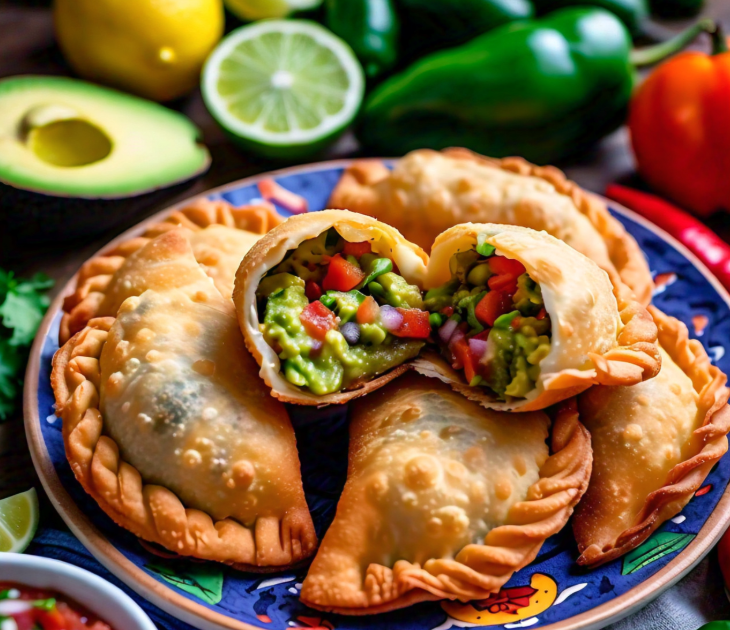
Common Ingredients in Mexican Empanadas
Mexican empanadas are a different ball game altogether. They reflect the vibrant and bold flavors of Mexican cuisine, relying heavily on indigenous ingredients and spices.
Unlike their Spanish counterparts, Mexican empanadas often feature corn flour (masa harina) instead of wheat flour, especially in rural regions. However, wheat-based dough is still used in certain areas. The choice of dough creates a noticeable difference in texture—corn dough results in a rustic, hearty empanada, while wheat dough produces a smoother, crispier finish.
When it comes to fillings, Mexican empanadas are nothing short of a flavor explosion. Here are some favorites:
- Picadillo: A spicy mix of ground beef, potatoes, carrots, and chiles.
- Pollo con Mole: Shredded chicken in a rich, chocolatey mole sauce.
- Rajas con Queso: Strips of roasted poblano peppers with melted cheese.
- Sweet Fillings: Empanadas can also be dessert-worthy, filled with guava, pineapple, sweet potato, or cajeta (caramelized goat’s milk).
The variety of fillings reflects Mexico’s diverse culinary regions and its love for combining savory, spicy, and sweet flavors.
Regional Variations of Mexican Empanadas
Mexico’s empanadas vary significantly from one region to another. For example:
- Yucatán: Empanadas in this region often use cochinita pibil (slow-cooked pork marinated in achiote and citrus) as a filling.
- Veracruz: Known for seafood empanadas filled with fish, shrimp, or crab.
- Central Mexico: More wheat-flour-based dough, featuring spicy fillings like chorizo and cheese.
These regional differences highlight how Mexico’s geography and cultural diversity influence its food.
How Are Mexican Empanadas Cooked?
Mexican empanadas are typically fried, although baked versions exist, especially in modern kitchens or urban areas. Frying gives Mexican empanadas their irresistible, crispy texture.
The corn-based empanadas are often flattened, filled, and folded before being deep-fried to golden perfection. This method ensures a crunchy exterior while keeping the filling warm and flavorful.
In some regions, bakers use a wood-fired oven to give their empanadas a smoky flavor, blending old-world techniques with modern convenience.
Key Differences Between Spanish and Mexican Empanadas
Now that we’ve explored the background, ingredients, and cooking methods of Spanish and Mexican empanadas, let’s put them side by side. What is the difference between Spanish empanadas and Mexican empanadas? While they may share a name, their execution is vastly different.
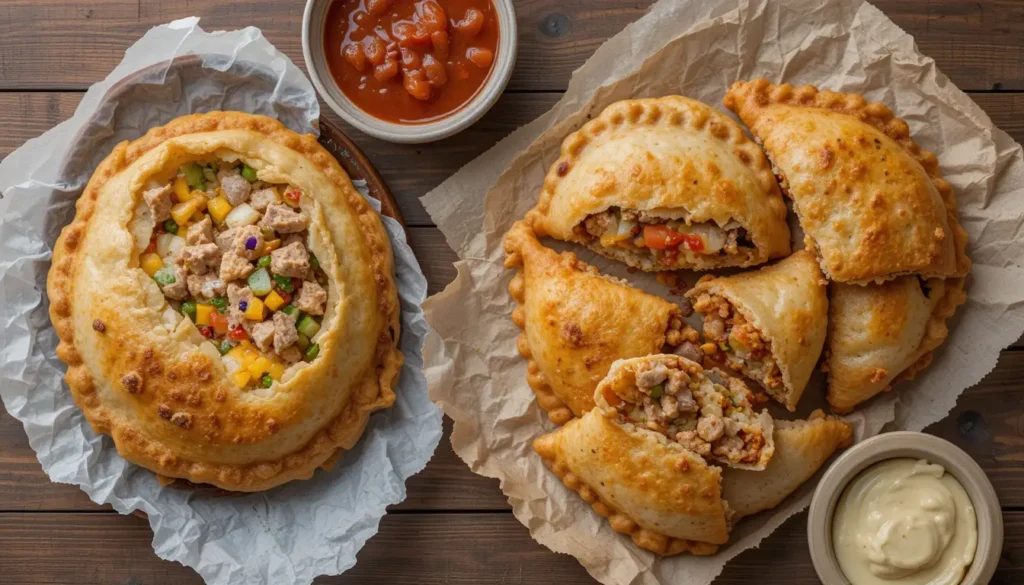
Dough Variations: Spanish vs. Mexican Style
The dough is one of the most fundamental differences between the two.
- Spanish Empanada Dough:
Spanish empanadas primarily use wheat flour, olive oil, and sometimes white wine. The dough is rolled thin and baked to a crisp, flaky texture. It resembles pie crust but with a richer, savory taste, thanks to the olive oil. - Mexican Empanada Dough:
Mexican empanadas vary in their dough types. Many traditional versions use corn-based dough (masa harina), a nod to Mexico’s indigenous roots. This gives the empanadas a rustic, hearty texture. However, in some urban areas, wheat-flour dough is also popular, especially for baked versions.
In essence, the Spanish version feels refined and flaky, while the Mexican one can range from rustic and crunchy to soft, depending on how it’s prepared.
Differences in Fillings: Sweet vs. Savory Options
Both Spanish and Mexican empanadas offer an array of fillings, but they differ in their focus.
- Spanish Fillings:
Spanish empanadas primarily focus on savory options like seafood, meats, and vegetables. You’ll rarely find sweet Spanish empanadas, as they’re more of a main course or hearty snack. - Mexican Fillings:
In Mexico, empanadas are far more versatile. They can be filled with anything from spicy meats to sweet fruits. For example:- Rajas con queso (poblano peppers with cheese) for a savory version.
- Guava, pineapple, or cajeta for dessert-style empanadas.
The diversity of Mexican fillings makes them adaptable to any time of day—breakfast, lunch, dinner, or dessert.
Cooking Methods: Baked vs. Fried Empanadas
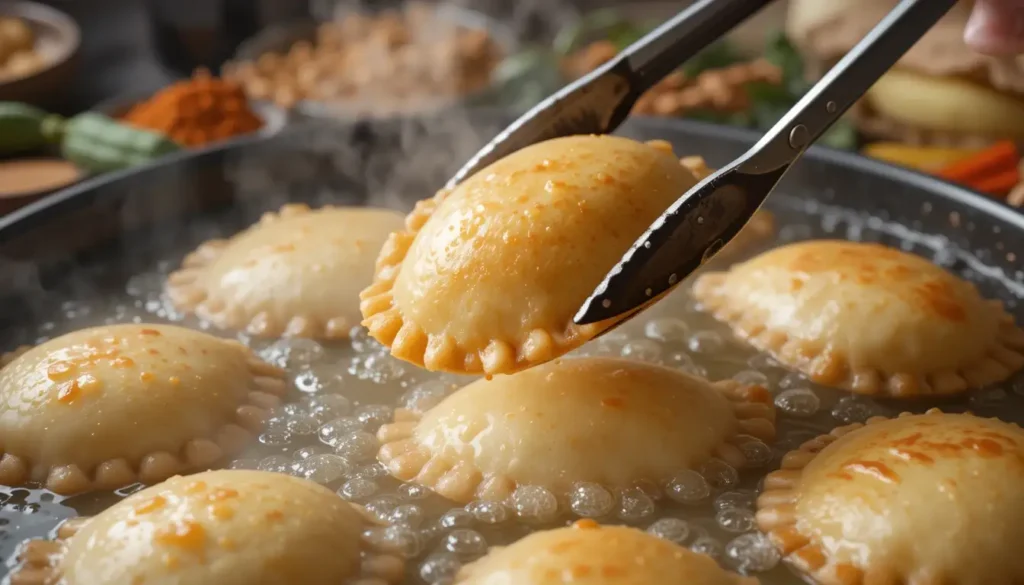
Cooking techniques play a significant role in how the empanadas look and taste.
- Spanish Empanadas:
Spanish empanadas are almost exclusively baked. Baking gives them a golden, crispy exterior and allows for large, family-sized empanadas to be served as pies. This makes them perfect for sharing at gatherings. - Mexican Empanadas:
In contrast, Mexican empanadas are often fried, especially when made with corn-based dough. Frying creates a crunchy, rustic texture that pairs well with their bold, flavorful fillings. However, baked empanadas are also popular in modern kitchens, where healthier options are prioritized.
The baked vs. fried difference creates unique flavor profiles and textures, offering two completely different experiences.
Flavor Profiles of Spanish and Mexican Empanadas
When you take a bite into a Spanish or Mexican empanada, you’ll immediately notice the contrast in flavor.
Mild and Savory Spanish Empanadas
Spanish empanadas lean towards mild and savory flavors, reflecting the Mediterranean style of cooking. Ingredients like olive oil, seafood, and paprika dominate the taste. There’s a focus on enhancing the natural flavors of the ingredients rather than overpowering them with spices.
For example, the classic empanada gallega features a harmonious mix of tuna, onions, and tomatoes, seasoned lightly with salt and paprika. The result is a balanced, comforting flavor.
Spicy and Bold Mexican Empanadas
Mexican empanadas are all about bold, vibrant flavors. They often feature chiles, spices, and indigenous ingredients that add a punch to every bite. Whether it’s the smoky heat of chipotle peppers or the sweet tang of guava, Mexican empanadas are anything but subtle.
Take picadillo, for instance—a popular filling made with ground beef, potatoes, and chiles. The spices used in picadillo infuse the empanada with layers of flavor, creating a spicy and hearty experience. On the sweeter side, empanadas filled with pineapple or cajeta bring a delightful balance of sweetness.
Mexican empanadas are a celebration of bold, spicy, and colorful cuisine.
How Geography and Culture Influence Empanada Preparation
The differences between Spanish and Mexican empanadas are deeply rooted in geography and culture.
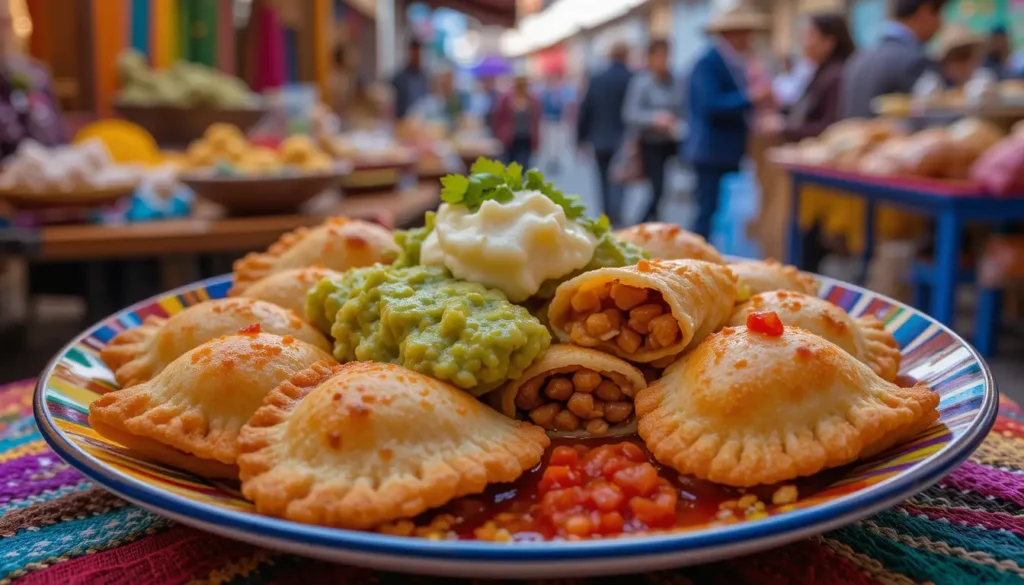
- Spanish Influence:
Spain’s coastal regions like Galicia shaped the preference for seafood-based fillings. The use of wheat flour and olive oil reflects Spain’s Mediterranean agricultural roots. Empanadas were traditionally baked, emphasizing family-style meals that could be shared. - Mexican Influence:
Mexico’s diverse geography and indigenous culture shaped its empanada variations. The use of corn flour reflects the importance of maize in Mexican cuisine, while the incorporation of bold spices and chiles stems from indigenous cooking practices. Frying empanadas became popular due to its simplicity and ability to achieve a crispy texture.
In both cases, empanadas are more than just food—they’re cultural artifacts that showcase regional traditions, ingredients, and techniques.
Popular Pairings and Accompaniments for Empanadas
Empanadas, whether Spanish or Mexican, are a versatile dish that pairs beautifully with a variety of sides, dips, and drinks. The accompaniments can enhance the flavors, turning a simple empanada into a complete meal or an impressive appetizer spread.
Spanish Empanada Pairings
Spanish empanadas, with their savory and mild flavors, pair well with simple, Mediterranean-style sides:
- Salads: A fresh green salad with olive oil, tomatoes, cucumbers, and a dash of vinegar complements the rich empanada filling.
- Aioli Sauce: This garlicky mayonnaise-based dip adds a creamy, zesty flavor that pairs perfectly with baked Spanish empanadas.
- Spanish Wines: A glass of red wine, such as Rioja, or a crisp white Albariño, enhances the delicate flavors of seafood and meat-filled Spanish empanadas.
- Pickled Vegetables: A small plate of olives or pickled peppers adds a tangy bite, cutting through the richness of the dough and filling.
These pairings reflect Spain’s traditional focus on fresh, light, and balanced accompaniments.
Mexican Empanada Pairings
Mexican empanadas, with their bold and spicy profiles, shine when paired with equally vibrant sides and dips:
- Salsa: Whether it’s a fresh pico de gallo, a smoky chipotle salsa, or a creamy avocado salsa, no Mexican empanada is complete without a dip.
- Guacamole: Creamy and zesty, guacamole balances the spiciness of fillings like picadillo or rajas con queso.
- Mexican Crema: A drizzle of this tangy, sour cream-like topping adds a cool contrast to fried empanadas.
- Rice and Beans: A side of seasoned rice and refried beans transforms Mexican empanadas into a hearty meal.
- Horchata or Agua Fresca: Sweet, refreshing drinks like horchata (a cinnamon-infused rice milk) or tamarind agua fresca are perfect for cooling the palate after a spicy empanada.
These accompaniments bring out the bold flavors of Mexican cuisine, creating a vibrant and satisfying meal experience.
Empanadas Around the World: A Global Perspective
While Spanish and Mexican empanadas are among the most well-known, these delightful stuffed pastries have traveled the world, taking on unique forms in different cultures.
Argentina: The Home of Beef Empanadas
Argentina takes pride in its empanadas, especially the empanadas de carne. These savory pastries feature wheat flour dough filled with seasoned ground beef, onions, olives, and hard-boiled eggs. Cooks either bake or fry them, depending on the region.
Each area in Argentina adds its own twist. In Salta, people prefer spicy versions, while Córdoba offers cheese-filled options. Empanadas in Argentina showcase the country’s love for high-quality beef and regional diversity, making them a staple in Argentine cuisine.
The Philippines: Empanadas with a Spanish Twist
Spanish colonization introduced empanadas to the Philippines, blending Spanish flavors with local ingredients. Filipino empanadas often use ground pork or chicken, potatoes, and peas for the filling. Some versions add raisins for a hint of sweetness. Unlike Spanish empanadas, cooks in the Philippines usually fry them, creating a crisp and golden crust.
These empanadas reflect the fusion of Spanish culinary traditions with Filipino creativity, resulting in a delicious, unique twist on this classic dish.
Portuguese Pastéis and African Empanadas
Portugal’s pastéis de bacalhau (codfish pastries) are close relatives of Spanish empanadas. These pastries often feature seafood wrapped in a crispy, golden dough. Similarly, in African countries like Angola and Cape Verde, empanadas have evolved into flavorful hand pies. Here, local ingredients blend with Portuguese culinary influences, creating unique variations.
For instance, in Angola, cooks often fill empanadas with spicy meats, reflecting the region’s bold flavors. Meanwhile, Cape Verde’s versions incorporate a mix of local and Portuguese ingredients, showcasing the cultural fusion. Overall, these empanadas demonstrate how food traditions adapt and evolve when they cross borders, combining heritage with local tastes.
FAQs
Are empanadas always savory?
No, many empanadas are savory, especially in Spain. However, Mexican empanadas are more versatile. They can include sweet fillings like guava, pineapple, or caramel.
Can you bake Mexican empanadas instead of frying them?
Yes! While frying is more common, you can bake Mexican empanadas for a healthier option. Baking gives them a crispy texture without the extra oil.
Which type of empanada is healthier—Spanish or Mexican?
Spanish empanadas tend to be healthier since baking reduces fat content. Mexican empanadas, often fried, contain more oil. However, the choice of filling and portion size also impacts their overall nutritional value.
What makes up empanada dough?
Spanish empanada dough uses wheat flour, olive oil, and sometimes white wine. Mexican empanada dough often includes corn flour (masa harina) but can also use wheat flour, depending on the region.
Can I make empanadas at home?
Absolutely! Making empanadas at home is simple. Choose your dough (wheat or corn), prepare a savory or sweet filling, and bake or fry them until golden. With so many recipes available, there’s something for every taste.
If you’re exploring the differences in other foods, you’ll enjoy reading The Difference Between Colombian and Venezuelan Empanadas.
Conclusion: Celebrating the Unique Flavors of Spanish and Mexican Empanadas
So, what is the difference between Spanish empanadas and Mexican empanadas? While both share the same concept, they reflect their unique cultural roots. Spanish empanadas offer a refined, flaky, and savory experience, often baked with Mediterranean-inspired fillings like seafood or chorizo. Mexican empanadas, on the other hand, burst with bold, spicy flavors, using corn or wheat dough and offering both savory and sweet options.
Whether you prefer the subtle elegance of Spanish empanadas or the vibrant flavors of Mexican versions, both celebrate tradition and creativity. Try them both—you might just discover a new favorite!
To learn about empanadas in other cultures, check out this article on Empanadas Venezolanas: A Culinary Delight with Deep Cultural Roots.

